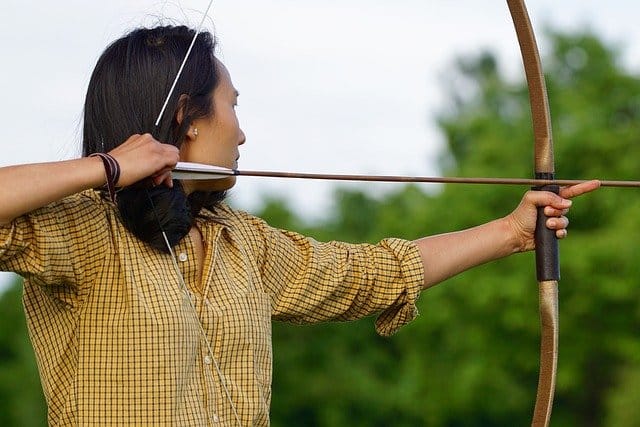Your bow, just like an old piano, can become out of tune. This means that the arrows don’t fly correctly or won’t sight-in. This can be troublesome to a hunter and deadly for those who rely on game to feed themselves. What are three ways to tell if your bow is out of tune?
There are a few different ways to tell that your bow is out of tune, but that could lead to more significant problems that keep food off the table and the deadly overpopulation of species. So read on and learn the three ways to tell if your bow is out of tune.

Three Ways to Tell if Your Bow is Out of Tune
Some folks have weird feelings about their bow and can tell within a few minutes of holding it if it is going to need work or not. This comes from time spent with the bow and a general sense built from years of shooting bows. There could be a few sure-fire ways to tell if your bow isn’t up to snuff for the rest of us.
Drop the Settings All the Way Down
Before you begin taking the bow out for some fun time, you will need to make a few adjustments. These adjustments help give a more precise diagnosis of your bow’s state. Once the settings are at the bottom, there are a few things to look for. First, make sure you drop the knocking location and rest down as far as they can go. Next, do the same with the cams and limbs.
Things to look for when you have the settings dropped down are:
- Cam Timing – Do the cams move and release at the same time? When cams are out of sync, it is a good indication that your bow is out of tune. Drawing the bow back to full draw should make both cams rotate and fully open.
- Limb Settings – Limbs are another vital moving piece of your bow. They control the tension created by the limbs and are a prime mover when the string is released. Take them down to their lowest, or a loose, setting and test their movement and recoil.
- Nock Point – The nock is another place to check for tuning issues. The nock can be moved and should be measured, between the axles, for the most effective place to prevent shaky arrows.
Starting at the bare minimum is always an excellent place, to begin with, bows. It gives strings a chance to stretch after being stored for a while, like the cams. Then, after a few months, cooped up in the case they could be a bit slow and need to move around a bit.
Shooting the Bow is the Vital Step to Determine if You are Out of Tune
Start by taking the bow out and getting in a few shots. Then, pick a close distance and a new target and let fly. Try and keep the movements mechanical and spaced across the face of the new target.
A few guidelines to try while test shooting your bow are:
- Same Distance – Keep the same distance while shooting. This allows the arrows to penetrate at the same depth, which shows how well the flight pattern of the arrow is working. A bow and arrow must have synced to make the arrows leave the rest level and with force.
- Draw Length – Draw the bow to the full length each time. Bows become out of tune when they send arrows downrange that are uneven and don’t penetrate at depth. Also, drawing to full length sends all the force down the arrow shaft, which causes wobbles.
Keep in mind that shooting will not be enough to let you know what else is going on with your bow. There are a few more steps in the process, but if you spend lots of time on the range, you should know within the first three or four shots if you are going in for a tune-up.
Did you know? Does draw length matter for recurve bows?
MUST READ! What happens if you fire a bow without an arrow?
Paper Tuning is Another Great Way to Determine if Your Bow Needs a Tune
Now that your shots have been impacting the target, evenly spaced with no close groupings, it is time to see if the paper can tell you anything about your bow. Again, paper is a great way to get some concrete results that will let you know if you need a tune.
A few things to look for when paper tuning are:
- Arrow Tears – The tears in the paper will be a great clue in your hunt. If the holes are ragged and do not have even tears, the arrows could be misfiring. First, check each impact area for clean cuts and places where you can tell the broadhead doesn’t impact the area squarely. Then, adjust your rest according to how the arrows have impacted.
- Impact Areas – The impact areas of the arrow will also let you know if you need a tune. They should be level when they impact the target. The holes they leave will look like tiny perfect circles in the canvas.
Paper Tuning tells you many things about the flight of the arrow that you cannot see with the naked eye. Looking at how the broadhead affects the paper is one of the best ways to tell how the arrow flies. Checking the arrow’s impact area will also let you know if the path is true.
Did you know? How long does arrows last?
Final Thoughts
There are many ways to see if your bow is out of tune. The most simple methods can be done in your backyard with just a few bits of targeting and sheets of paper. Remember to be easy when removing arrows from paper targets, as the paper is going to be what lets you know if you need a tune.
Whatever kind of method you choose, know that a professional will need to do most of the work on your bow. They have specialized machines that allow them to test the trueness of the bow and the arrows that aren’t readily available to the layperson.


